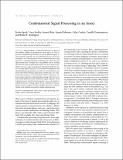Files in this item
Combinatorial signal processing in an insect
Item metadata
| dc.contributor.author | Speck, Bretta | |
| dc.contributor.author | Seidita, Sara | |
| dc.contributor.author | Belo, Samuel | |
| dc.contributor.author | Johnson, Samuel | |
| dc.contributor.author | Conley, Caley | |
| dc.contributor.author | Desjonquères, Camille | |
| dc.contributor.author | Rodríguez, Rafael L | |
| dc.date.accessioned | 2021-09-07T23:39:29Z | |
| dc.date.available | 2021-09-07T23:39:29Z | |
| dc.date.issued | 2020-10 | |
| dc.identifier | 270806469 | |
| dc.identifier | 65692ed4-eefc-4a0d-ac17-359f94fe354d | |
| dc.identifier | 32970471 | |
| dc.identifier | 85090984516 | |
| dc.identifier.citation | Speck , B , Seidita , S , Belo , S , Johnson , S , Conley , C , Desjonquères , C & Rodríguez , R L 2020 , ' Combinatorial signal processing in an insect ' , American Naturalist , vol. 196 , no. 4 , pp. 406-413 . https://doi.org/10.1086/710527 | en |
| dc.identifier.issn | 0003-0147 | |
| dc.identifier.other | ORCID: /0000-0002-6150-3264/work/83086205 | |
| dc.identifier.uri | https://hdl.handle.net/10023/23920 | |
| dc.description.abstract | Human language is combinatorial: phonemes are grouped into syllables, syllables are grouped into words, and so on. The capacity for combinatorial processing is present, in different degrees, in some mammals and birds. We used vibrational insects, Enchenopa treehoppers, to test the hypothesis of basic combinatorial processing against two competing hypotheses: beginning rule (where the early signal portions play a stronger role in acceptability) and no ordering rule (where the order of signal elements plays no role in signal acceptability). Enchenopa males use plant-borne vibrational signals that consist of a whine followed by pulses. We tested the above hypotheses with vibrational playback experiments in which we presented Enchenopa females with stimuli varying in signal element combinations. We monitored female responses to these playbacks with laser vibrometry. We found strong support for combinatorial processing in Enchenopa: in brief, females preferred natural-combination signals regardless of the beginning element and discriminated against reverse-order signals or individual elements. Finding support for the combinatorial rule hypothesis in insects suggests that this capability represents a common solution to the problems presented by complex communication. | |
| dc.format.extent | 8 | |
| dc.format.extent | 636483 | |
| dc.language.iso | eng | |
| dc.relation.ispartof | American Naturalist | en |
| dc.subject | Communication | en |
| dc.subject | Mate choice | en |
| dc.subject | Signal processing | en |
| dc.subject | Phonology | en |
| dc.subject | Syntax | en |
| dc.subject | Vibrational signaling | en |
| dc.subject | QH301 Biology | en |
| dc.subject | DAS | en |
| dc.subject.lcc | QH301 | en |
| dc.title | Combinatorial signal processing in an insect | en |
| dc.type | Journal article | en |
| dc.contributor.institution | University of St Andrews. School of Biology | en |
| dc.identifier.doi | https://doi.org/10.1086/710527 | |
| dc.description.status | Peer reviewed | en |
| dc.date.embargoedUntil | 2021-09-08 |
This item appears in the following Collection(s)
Items in the St Andrews Research Repository are protected by copyright, with all rights reserved, unless otherwise indicated.

